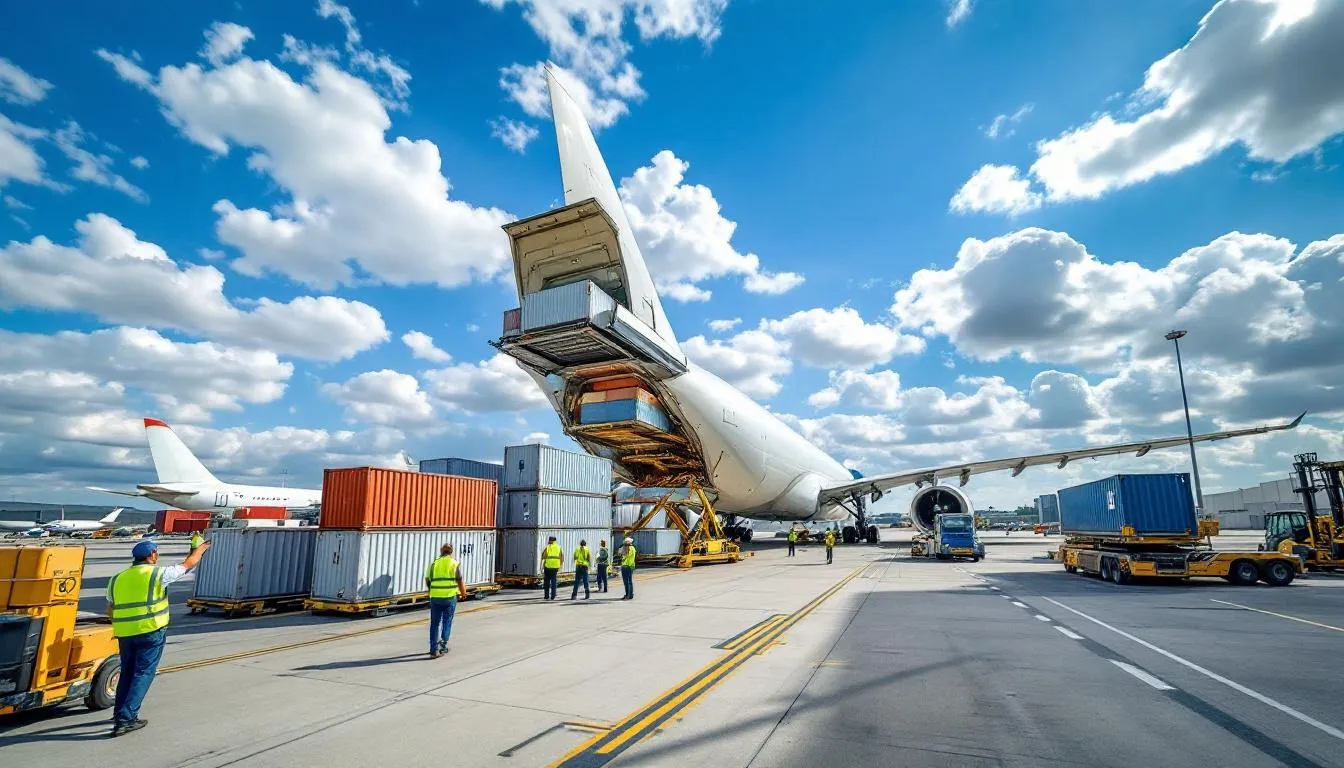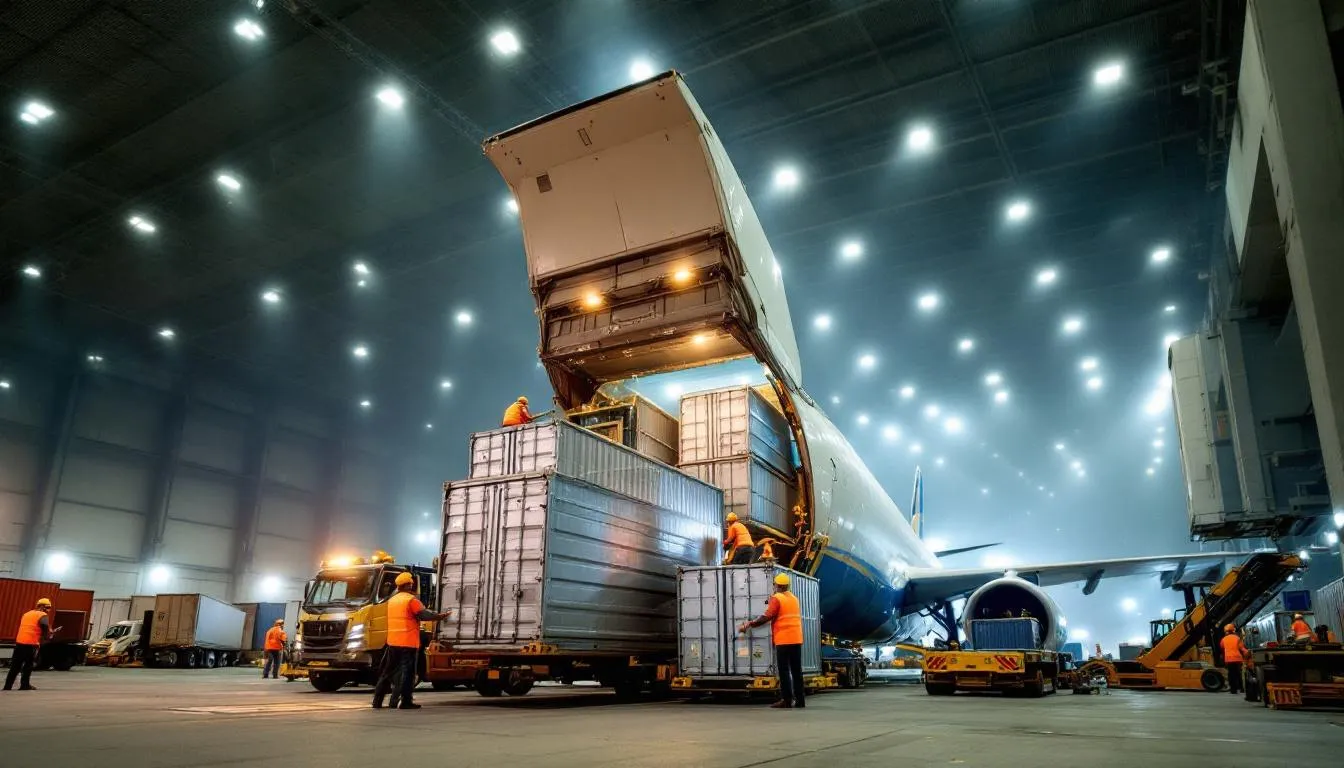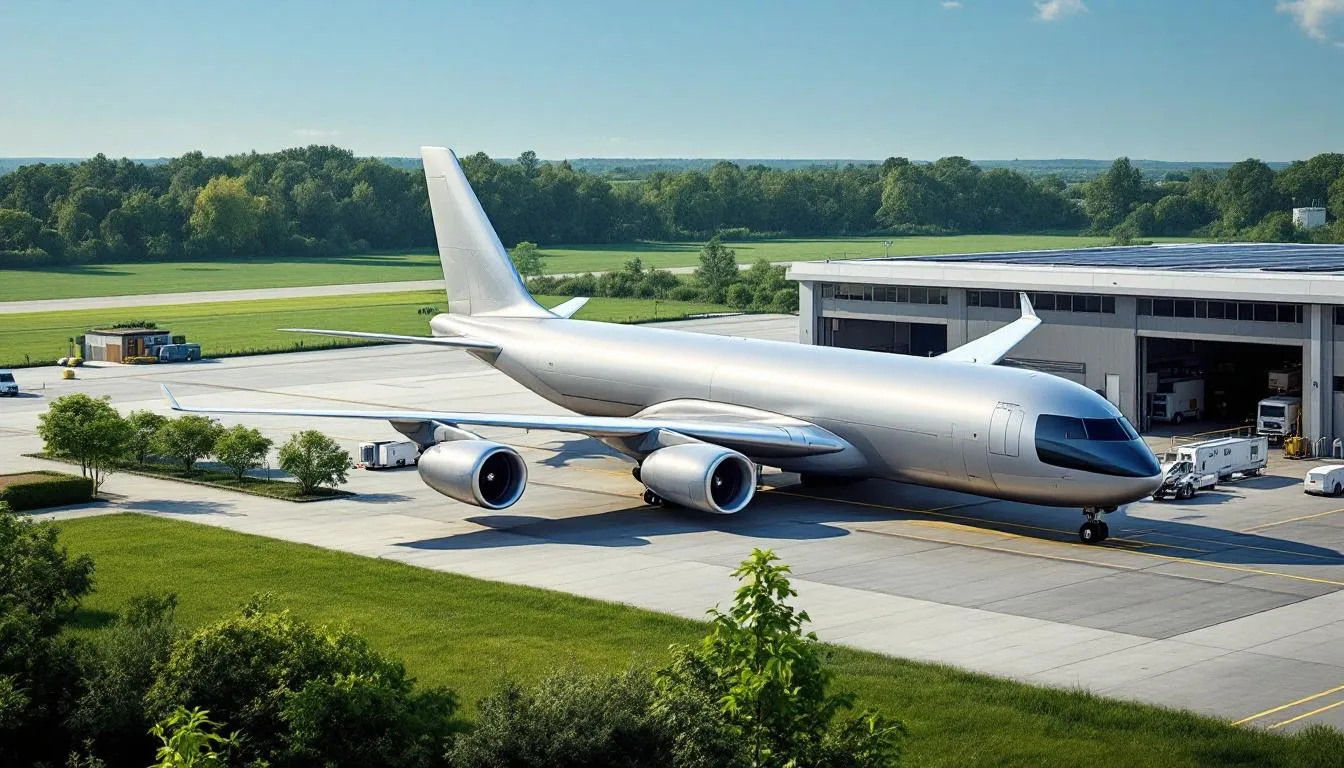Key Takeaways
- Air freight reduces shipping time from 20-30 days (ocean) to just 3 days for routes like China to the US, making it ideal for urgent shipments.
- Pre-COVID rates ranged $2.50-$5.00/kg, spiked to $4.00-$8.00/kg during the pandemic, and settled around $3.00-$7.00/kg in 2023
- Express air freight handles smaller shipments under 200kg with door-to-door service, while international air freight accommodates much larger cargo volumes.
- Air carriers charge by volumetric weight (volume x 167) or actual weight, whichever is higher, significantly impacting final shipping costs.
- Best suited for high-value, time-sensitive, or perishable goods like electronics, pharmaceuticals, and urgent business shipments
The global supply chain depends heavily on efficient transportation methods that can deliver goods quickly and reliably across vast distances. While ocean freight dominates international shipping by volume, air freight shipping has become indispensable for businesses that prioritize speed over cost. This comprehensive guide explores everything you need to know about air freight services, from pricing structures to choosing the right solution for your business needs.
In today’s interconnected world, the ability to ship products rapidly can mean the difference between capturing market opportunities and losing them to competitors. Whether you’re a manufacturer needing urgent spare parts or a retailer launching time-sensitive products, understanding air freight options will help you make informed decisions that can save time and optimize your logistics operations.
What is Air Freight?
Air freight is the transportation of goods by aircraft, offering the fastest method for international and domestic cargo. This transportation mode utilizes a global air cargo network that serves over 14,000 origins and destinations across more than 140 countries, connecting major cities and remote locations alike through sophisticated logistics networks.
The air cargo industry has evolved from simple mail delivery to a complex ecosystem that handles everything from urgent business documents to heavy machinery. Modern air freight operations involve specialized aircraft, advanced cargo handling systems, and digital platforms that provide real-time visibility throughout the shipping process. This integration of digital technologies has transformed how freight forwarders and shippers manage their operations.
When comparing air freight to ocean freight, the trade-offs become immediately apparent. While ocean freight can take 20-30 days for major trade routes like China to the United States, air freight typically delivers the same shipment in 3-5 days. However, this speed comes with a hefty price tag – air freight costs can be 5-10 times higher than ocean freight for the same shipment weight.
The role of air freight in modern supply chains extends beyond simple transportation. It enables just-in-time delivery systems that allow businesses to reduce inventory holding costs while maintaining responsive customer service. This capability has become particularly valuable for industries dealing with high-value products or those facing unpredictable demand patterns.
Types of Air Freight Services
Express Air Freight
Express air freight is the premium tier of air cargo services, offering door-to-door service managed by single carriers such as DHL, UPS, and FedEx. These services are specifically designed for smaller shipments, typically under 200kg, where speed and convenience justify premium pricing.
The express model provides comprehensive service, including pickup from the shipper’s location, customs clearance, transportation, and final delivery to the recipient’s door. This end-to-end visibility and control make express services particularly attractive for businesses that need guaranteed delivery times. Most express carriers offer delivery times of 1-3 business days to major cities worldwide, with some services offering next-day delivery to domestic and select international destinations.
Express air freight services operate their own aircraft fleets and ground networks, allowing them to maintain strict control over the entire shipping process. This vertical integration enables them to offer service guarantees and real-time updates that traditional freight forwarders using multiple carriers cannot match. However, this premium service comes with correspondingly higher freight rates.
Digital freight solutions have enhanced express services through mobile apps, automated booking systems, and advanced shipment tracking capabilities. Customers can now receive real-time updates, electronic proof of delivery, and detailed analytics about their shipping patterns.
International Air Freight
International air freight serves the bulk cargo market, accommodating shipments from 150kg to entire aircraft loads. Unlike express services, international air freight typically involves multiple parties —freight forwarding services, air carriers, and ground handling companies —working together to move cargo efficiently.
This service category covers both port-to-port and door-to-door delivery options, with freight forwarders coordinating the complex logistics required for larger shipments. The international air freight network spans over 600 airports and 300 operating facilities globally, providing extensive coverage for businesses with diverse shipping needs.
Traditional freight forwarders and digital freight forwarders both play crucial roles in international air freight operations. While traditional freight forwarders rely on established relationships and manual processes, digital freight forwarders leverage digital tools and data analytics to provide enhanced shipment visibility and more competitive pricing.
The cargo capacity of international air freight varies significantly based on aircraft type and route. Dedicated cargo aircraft can handle much larger volumes than passenger aircraft’s belly hold, which becomes particularly important during peak shipping seasons when capacity is constrained.
Air Freight Pricing and Costs
How Air Freight Rates are Calculated
Air freight pricing uses a unique system that considers both actual and volumetric weight, charging based on whichever is higher. The volumetric weight calculation uses the formula: volume in cubic meters multiplied by 167, or length x width x height in centimeters divided by 6,000.
This pricing structure means that lightweight but bulky items often incur charges based on their volume rather than actual weight. For example, a shipment of pillows weighing 50kg but occupying two cubic meters would be charged for 334kg (2 x 167) of chargeable weight. Understanding this calculation is crucial for shippers to estimate their total cost accurately.
Base freight rates represent only part of the total shipping cost. Additional charges typically include fuel surcharges, security fees, terminal handling charges, and customs clearance fees. These surcharges can add 20-40% to the base rate, making accurate cost calculation complex without proper tools.
Online calculator tools and digital platforms now provide instant freight quotes that factor in all applicable charges. These digital solutions have made it easier for businesses to compare options and make informed decisions about their air freight shipping needs.
Factors Affecting Air Freight Costs
Fuel surcharges are among the most significant variable costs in air freight pricing. These charges fluctuate with jet fuel prices and can change weekly, making budget planning challenging for regular shippers. During periods of high fuel costs, surcharges can represent 15-25% of the total shipping cost.
Destination-specific factors significantly impact pricing, with routes to remote locations or countries with limited air cargo capacity commanding premium rates. For instance, shipping to destinations like South Sudan or Saint Martin typically costs more than shipping to major cities due to limited flight options and cargo capacity constraints.
Seasonal demand fluctuations create predictable pricing patterns, with peak seasons around major holidays seeing substantial rate increases. During these periods, cargo capacity becomes scarce, and carriers implement peak-season surcharges that can double normal rates on popular routes.
Special handling requirements add additional costs for dangerous goods, oversized cargo, or temperature-controlled shipments. These services require specialized equipment and trained personnel, which justifies higher pricing while ensuring proper handling of sensitive cargo.
Benefits of Air Freight Shipping
Air freight offers unmatched speed in global transportation, enabling businesses to meet urgent delivery requirements that other transportation modes cannot accommodate. This speed advantage becomes particularly valuable when shipping process delays could disrupt production schedules or customer commitments.
The reliability and consistency of air freight scheduling provide businesses with predictable delivery times, enabling better planning and customer service. Unlike ocean freight, which can face significant delays due to port congestion or weather, air freight maintains more consistent schedules with minimal weather-related disruptions.
Reduced inventory holding costs represent a significant financial benefit for companies that strategically use air freight. By enabling just-in-time delivery, businesses can reduce warehouse space requirements and minimize capital tied up in inventory while maintaining responsive customer service levels.
Enhanced security and tracking capabilities throughout the air freight shipping process provide shippers with greater confidence in their cargo’s safety. Modern air cargo operations include sophisticated tracking systems that provide real-time visibility from pickup to final delivery, helping businesses maintain better control over their supply chain operations.
The global reach of air freight networks connects remote destinations efficiently, often providing the only viable option for reaching specific locations within reasonable time frames. This connectivity supports businesses expanding into new markets or serving customers in geographically challenging locations.
Disadvantages of Air Freight
The most significant disadvantage of air freight is its substantially higher costs compared to ocean freight, particularly for large or heavy shipments. While ocean freight might cost $1-3 per kilogram on major routes, air freight typically costs $3-7 per kilogram, making it economically unfeasible for many bulk shipments.
Strict size and weight limitations restrict the types of cargo that can be effectively transported by air freight. Aircraft door dimensions and cargo hold configurations limit the transport of oversized items, while weight restrictions prevent the efficient transportation of cumbersome items that other transportation modes routinely handle.
Environmental impact considerations have become increasingly important as businesses focus on sustainability. Air freight generates significantly higher carbon emissions per kilogram compared to ocean freight, making it a less environmentally friendly option for companies prioritizing reduced environmental impact.
Limited capacity during peak seasons creates additional challenges, as cargo space becomes scarce and rates increase substantially. This capacity constraint can force shippers to either pay premium rates or delay shipments, potentially disrupting business operations.
Restrictions on dangerous goods and hazardous materials limit what can be shipped via air freight. While ocean freight can accommodate a broader range of restricted items with proper documentation, air cargo has more stringent limitations that may require alternative transportation methods.
What Products are Best Suited for Air Freight
High-value electronics and technology products represent ideal candidates for air freight due to their favorable weight-to-value ratios and time-sensitive market requirements. These products typically justify the higher transportation costs through reduced inventory holding costs and faster market entry.
Time-sensitive pharmaceuticals and medical supplies rely heavily on air freight for temperature-controlled transportation and rapid delivery. The pharmaceutical industry’s strict supply chain requirements and urgent patient needs often make air freight the only viable option for critical medications and medical devices.
Perishable goods, including fresh produce, flowers, and specialty food items, depend on air freight’s speed to maintain quality and maximize shelf life. The ability to deliver fresh products from remote growing regions to global markets within days rather than weeks provides significant value that justifies higher transportation costs.
Urgent spare parts and emergency industrial components represent another key market for air freight services. When production lines experience unexpected equipment failures, the cost of downtime often far exceeds air freight charges, making rapid parts delivery essential to minimize business disruption.
Fashion and seasonal merchandise with tight delivery windows benefit from air freight’s ability to respond quickly to market demands. Fast fashion retailers and seasonal businesses often use air freight to ensure products reach markets while demand remains strong.
Documents and samples requiring next-day delivery continue to account for a significant share of express air freight volume, despite digital alternatives. Legal documents, product samples, and time-sensitive business materials often require physical delivery that only air freight can provide within required timeframes.
Air Freight Market Trends and Outlook
The post-pandemic air freight market has shown remarkable resilience, with rates stabilizing around $3.00-$7.00 per kilogram in 2023 after experiencing significant volatility during 2020-2022. This stabilization reflects improved capacity management and normalized demand patterns as global trade recovers.
Increased demand driven by ocean freight delays and supply chain disruptions has permanently elevated air freight’s role in global logistics. Many shippers who traditionally relied exclusively on ocean freight have diversified their transportation mix to include air freight for critical shipments, creating sustained demand growth.
The growth in e-commerce continues to drive express air freight volume increases, particularly for cross-border shipments. Digital marketplaces and direct-to-consumer businesses rely heavily on air freight to meet customer expectations for rapid delivery, creating new opportunities for freight companies offering specialized e-commerce solutions.
Digital transformation initiatives across the logistics industry have improved booking, tracking, and customer service capabilities. Digital freight platforms now offer sophisticated tools for rate comparison, automated booking, and enhanced shipment visibility that were previously available only to large enterprise customers.
Sustainability initiatives are driving the development of greener air cargo solutions, including more fuel-efficient aircraft and research into alternative fuels. While environmental concerns create challenges for the industry, they also drive innovation that may reduce the ecological impact gap between air and ocean freight.
How to Choose the Right Air Freight Service
Service-level comparison requires understanding the trade-offs among the Premium Direct (1-2 days), Direct (2-3 days), and Consolidated (3-5 days) options. Premium services offer guaranteed delivery times and priority handling but command the highest rates, while consolidated services provide cost savings through shared cargo capacity.
Carrier selection criteria should include network coverage, reliability records, and specialized service capabilities. Major carriers like DHL, UPS, and FedEx offer extensive global networks with consistent service quality, while regional airlines may provide better pricing for specific routes or specialized handling requirements.
Cost-benefit analysis for urgent versus standard air freight options requires evaluating the true cost of delays against premium service charges. For many businesses, the cost of stockouts, production delays, or customer dissatisfaction far exceeds the additional cost of premium air freight services.
Integration with existing supply chain and logistics systems should influence carrier selection, particularly for businesses requiring seamless data exchange and automated processes. Digital freight solutions often provide better integration capabilities than traditional freight forwarders, enabling more efficient operations.
Insurance and liability coverage considerations become particularly important for high value shipments or critical cargo. Understanding maximum liability limits and available insurance options helps ensure adequate protection against potential losses during transportation.
FAQ
How much does air freight cost per kilogram?
Air freight rates typically range from $3.00-$7.00 per kilogram in 2023, though this varies significantly based on route, service level, and market conditions. Express services command premium pricing 20-40% higher than standard air freight, while routes to remote destinations or during peak seasons can see rates increase substantially. Fuel surcharges, security fees, and other factors often add 20-30% to base rates, making the total cost higher than quoted freight rates alone.
What is the difference between volumetric weight and actual weight?
Volumetric weight is calculated by multiplying a shipment’s dimensions in cubic meters by 167, while actual weight is the physical weight measured on a scale. Airlines charge based on whichever is higher – actual weight or volumetric weight. This means lightweight but bulky items like clothing or electronics packaging often incur charges based on their volume rather than actual weight, significantly impacting shipping costs for low-density cargo.
How long does air freight take compared to ocean shipping?
Air freight typically takes 1-5 business days depending on service level and destination, with express services delivering in 24-48 hours to major global cities. Ocean freight averages 20-30 days for major trade routes like China to the US, making air freight 5-10 times faster. However, this speed advantage comes with costs 5-10 times higher than ocean freight, making it suitable primarily for urgent or high-value shipments where time savings justify the additional expense.
What items cannot be shipped via air freight?
Dangerous goods including flammable liquids, explosives, compressed gases, and corrosive materials require special certification and handling procedures that many air freight services cannot accommodate. Oversized cargo exceeding aircraft door dimensions (typically around 3.5m x 2.4m) and weight limits cannot be shipped via standard air freight. Prohibited items vary by destination country but commonly include weapons, drugs, certain chemicals, and live animals without proper documentation and specialized air cargo services.
When should I choose air freight over ocean freight?
Choose air freight for urgent shipments where delivery speed justifies the higher cost, typically for items needed within days rather than weeks. High-value goods where faster transit reduces inventory holding costs and theft risk often benefit from air freight despite higher transportation charges. Perishable products requiring quick delivery to maintain quality, and situations where ocean freight delays risk disrupting production schedules or customer commitments also favor air freight. The decision ultimately depends on balancing transportation costs against the business impact of longer delivery times.






Leave A Comment
You must be logged in to post a comment.